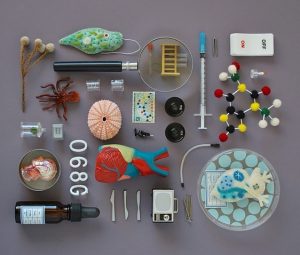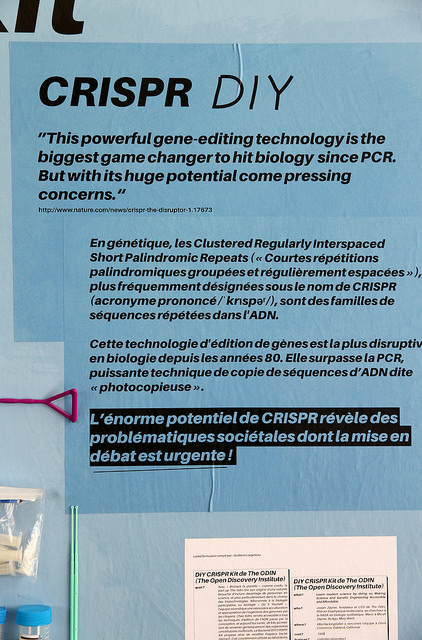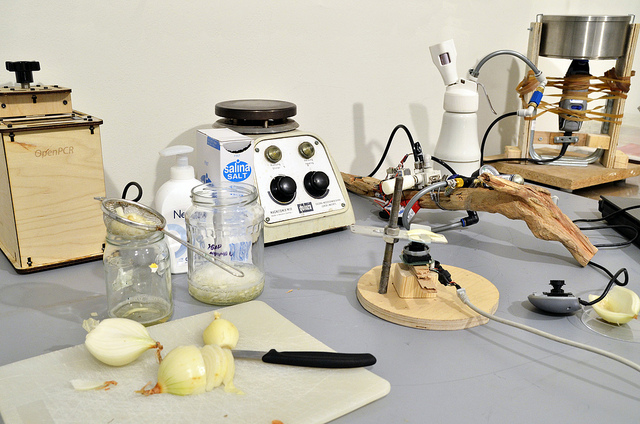Morgan Meyer
The exploration of amateurs in natural history, garage biology or the self-construction of agricultural equipment has the common interest of leading to places, practices and collectives that are located outside or at the boundaries of scientific institutions. It is  not only because they force us to look beyond laboratories, universities and research centres that alternative ways of producing knowledge, manufacturing equipment and creating networks constitute a relevant research theme. Their relevance also lies in what they afford: another look at science, its limits, its hierarchies, its confinements.
not only because they force us to look beyond laboratories, universities and research centres that alternative ways of producing knowledge, manufacturing equipment and creating networks constitute a relevant research theme. Their relevance also lies in what they afford: another look at science, its limits, its hierarchies, its confinements.
By following the translations and circulations that take place between the scientific world and other worlds, the issue of boundaries, of participation, and the issue of intermediation become particularly salient. My research is thus interested in science through a three-fold approach: to capture the materiality and spatiality of science by paying attention to the places, textures, objects and boundaries of scientific practices; to follow emerging practices and disciplines, and objects in the making or even controversial objects; to problematize the idea of “participatory” science and technology by examining the grammar and registers of action of participation.
Rethinking participation and co-production of knowledge
One of my current research fields is “garage” biology or “do-it-yourself ” biology. This biology is based upon different practices and logics:
- amateur and DIY practices,
- ethics of hacking and open source,
- willingness to domesticate molecular biology and genetics,
- ideal of participation and citizen science.
To say that garage biology “democratizes” science is a bit too simplistic. It is my contention that in order to understand what is at stake with this democratization, not only do we need to consider that it is a process, we also need to present its concrete dimensions. This approach allows for a description of the democratization of science at stake within garage biology as a process that is at once spatial (construction of new spaces), technical (creative workarounds around equipment), social (creation of  accessible networks/laboratories) as well as political. In other words, processes of democratization and participation need to be examined through their gestures, grammar and registers of action, such as tinkering, experimenting, working around, comparing, making affordable, sharing, demystifying, liberating, empowering, hacking.
accessible networks/laboratories) as well as political. In other words, processes of democratization and participation need to be examined through their gestures, grammar and registers of action, such as tinkering, experimenting, working around, comparing, making affordable, sharing, demystifying, liberating, empowering, hacking.
The different forms of “valuation” in the field of garage biology are another process that needs to be understood. Both market valuations (with its investments, products and markets) and non-market valuations (social, ethical and cultural) can be observed. These valuations are particularly distributed and heterogeneous: products are valuated at the same time than practices, principles, places or forms of organization. These valuations are supposed to produce interest in a three-fold sense: a general interest (public good), an interest for the public (curiosity) and a monetary interest (by making other people financially participate).
On the other hand, the low-tech and “convivial” aspects of technologies are frequently put forward: especially in open source agriculture, which I explore through the self-construction of agricultural equipment by the cooperative l’Atelier Paysan (Chance & Meyer, 2017) and various collectives in Greece (Meyer & Pantazis, 2018).
New configurations and communities in biology
Synthetic biology also offers a particularly fertile ground for examining new scientific communities. We have proposed the notion of “community-making devices” to conceptualize markers and makers of community (Molyneux-Hodgson & Meyer, 2009). Emerging scientific communities, such as synthetic biology, draw on a  repertoire of devices – associations, journals, conferences, promises, “success stories” – that aim to create a sense of belonging to collectives and to align the practices, objects, objectives and futures of scientists.
repertoire of devices – associations, journals, conferences, promises, “success stories” – that aim to create a sense of belonging to collectives and to align the practices, objects, objectives and futures of scientists.
While the notion of “epistemic community” has its strengths – it emphasizes the collective nature of knowledge production and the positioning of collectives in relation to politics – it often refers to a relatively cognitivist conception of the diffusion of knowledge among experts – experts who organize themselves in an almost natural and linear way in communities, in response to a political issue. We need to redefine what “epistemic communities” are by problematizing them in four ways:
- Epistemic communities produce and “act with” knowledge (by producing, publicising, distributing, accumulating and politicizing knowledge);
- they are fabricated and stabilized;
- they are dynamic (they have diverse histories, futures and possibilities, and they differentiate, change, transform and politicize themselves);
- and finally, in addition to producing objects of knowledge, they also produce knowledge producers (their identities and their individual and collective trajectories).
But it is also necessary to invent new concepts, such as “placing” – which refers to the idea of positioning, situating, locating (Meyer & Molyneux-Hodgson, 2016). This concept makes it possible to grasp and link entities generally differentiated as “local” (universities, research teams), “national” (funding, public policies, public debates, platforms) and “non-local” (international competitions, conferences and publications). It also forces us to move empirically between several sites and thus understand the processes by which the social, the material and the technical co-construct themselves, and how synthetic biology is positioned in a space (disciplinary, institutional, geopolitical or public). The current debates around CRISPR and genome editing are another site where these issues are particularly visible and need further exploration.
Intermediations
Whether it is knowledge brokers, science shops or technology transfer offices, we are witnessing an institutionalization, professionalization and formalization of activities and places of intermediation. This Intermediation is particularly salient in the case of knowledge brokers and translational medicine. And it leads us to rethink notions such as translation, brokerage, mediation, intermediation, or exploration.
The movement and positioning of knowledge brokers is often described as an “in-between world”. However, the movements – actual or imagined – are more complex and multiform than a simple back and forth movement in-between two worlds. It is the geography of the work of intermediaries, their  trajectories and positioning practices that need therefore to be made explicit. I was able to show that, by moving around, an intermediary accomplishes a triple task: 1) put knowledge into circulation, 2) translate and transform it, and, 3) ultimately, make it more robust. The final product of this circulation and translation of knowledge is a new form of knowledge: a “brokered knowledge”. This “brokered” knowledge is knowledge that has been de-assembled and re-assembled, knowledge that has been made more robust and usable, and knowledge that is to be used locally at a given time.
trajectories and positioning practices that need therefore to be made explicit. I was able to show that, by moving around, an intermediary accomplishes a triple task: 1) put knowledge into circulation, 2) translate and transform it, and, 3) ultimately, make it more robust. The final product of this circulation and translation of knowledge is a new form of knowledge: a “brokered knowledge”. This “brokered” knowledge is knowledge that has been de-assembled and re-assembled, knowledge that has been made more robust and usable, and knowledge that is to be used locally at a given time.
The issue of translation and mobilization of knowledge is also central in my academic position. I often translate my research for non-academic audiences through the writing of texts aimed at the general public (among others d’Lëtzebuerger Land), participating in radio programs and interviews, collaborations with museums (Medical Museion, Copenhagen; Science Museum, London; Deutsches Museum, Munich), or the mobilization of my research work through expertise (for OECD, CCNE, INRA).
References
Chance Quentin & Meyer Morgan (2017). L’agriculture libre. Les outils agricoles à l’épreuve de l’open source, Techniques & Culture [En ligne], Suppléments au n°67.
Meyer Morgan (2006) Partially Connected to Science: the Luxembourg Museum of Natural History and its Scientific Collaborators, PhD thesis, University of Sheffield.
Meyer Morgan & Kearnes Matthew (Eds.) (2013). Special Section: Intermediaries between Science, Policy and the Market. Science and Public Policy, 40(4).
Meyer Morgan & Molyneux-Hodgson Susan (2016). Placing a New Science: Exploring Spatial and Temporal Configurations of Synthetic Biology. In Merz Martina, & Sormani Philippe (Eds.). The Local Configuration of New Research Fields: On Regional and National Diversity, Springer, pp 61-77.
Meyer Morgan & Pantazis Alekos (July 2018). Making, adapting, sharing: fabricating open-source agricultural tools. P2P Foundation.
Molyneux-Hodgson Susan & Meyer Morgan (2009). Tales of Emergence—Synthetic Biology as a Scientific Community in the Making. BioSocieties 4(1-2): 129–145.
Photo #1 – hine, “Miniature Collage-Bioscience”, September 18, 2014. BY NC ND
llustration #2 – Plans of Neo-Bucher (soil tillage tool) distributed under free license by the Atelier Paysan. CC BY NC SA.
Photo #3 – Sylvia Fredriksson, “CRISPR DIY“, Biennale Internationale du Design 2017, 8 April, 2017. BY
Photo #4 – Martin Malthe Borch, “Characters on the lab bench“. Medical Museion”, January 15, 2013. BY CC SA.

